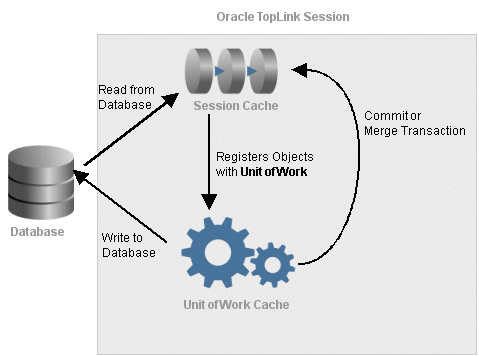|
Oracle TopLink Developer's Guide
10g Release 3 (10.1.3) B13593-01 |
|
 Previous |
 Next |
|
Oracle TopLink Developer's Guide
10g Release 3 (10.1.3) B13593-01 |
|
 Previous |
 Next |
TopLink uses two types of cache: the session cache maintains objects retrieved from and written to the data source; and the unit of work cache holds objects while they participate in transactions. When a unit of work successfully commits to the data source, TopLink updates the session cache accordingly.
As Figure 90-1 shows, the session cache and the unit of work cache work together with the data source connection to manage objects in a TopLink application. The object life cycle relies on these three mechanisms.
Figure 90-1 Object Life Cycle and the TopLink Caches

The session cache is a shared cache that services clients attached to a given session. When you read objects from or write objects to the data source using a client session, TopLink saves a copy of the objects in the parent server session's cache and makes them accessible to all other processes in the session.
TopLink adds objects to the session cache from the following:
The data store, when TopLink executes a read operation
The unit of work cache, when a unit of work successfully commits a transaction
An isolated client session is a special type of client session that provides its own session cache isolated from the shared object cache of its parent server session. The isolated client session cache can be used to improve user-based security or to avoid caching highly volatile data. For more information, see "Isolated Client Sessions".